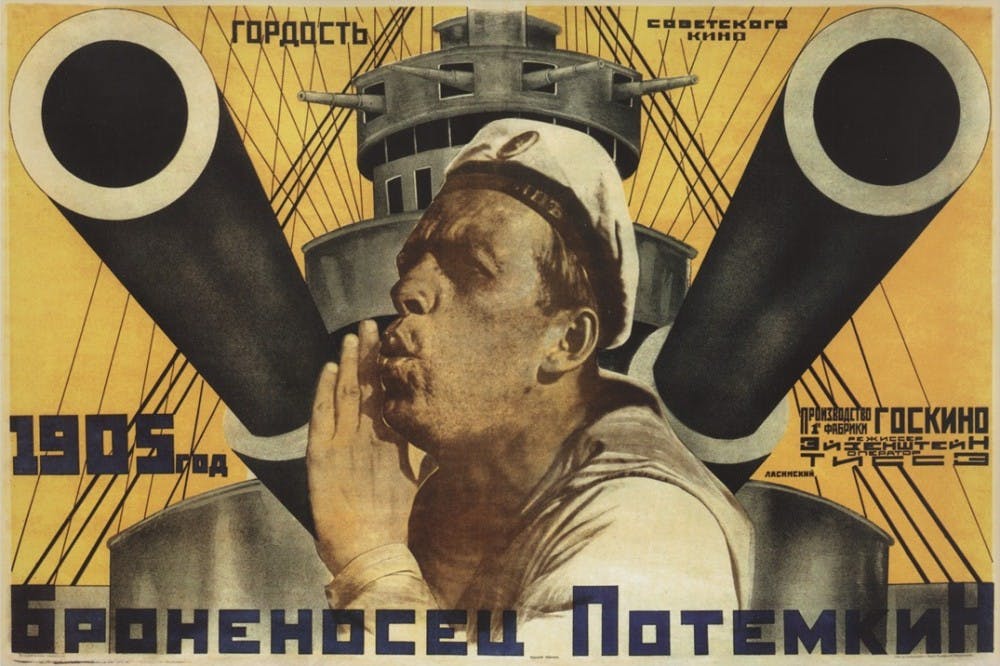Despite the absence of a single functioning cinema in Moscow until 1922, Soviet Cinema prolifically flourished within a matter of years. Only a year later in 1923, an additional 89 cinemas had begun operation within the Union of Soviet Socialist Republics. In its earliest stage, Soviet Cinema was composed largely of agitki—didactic propaganda films meant to agitate and induce the masses to participate in the new order of Soviet political life. Reaching countryside to countryside, such short reel films exposed countless Soviet peasants to motion pictures.
As the number of places for film screenings increased, filmmakers who were willing to adjust their work to the Soviet worldview saw a place for creation of filmic works. Promoting socialist realism, an artistic style buttressing communist values, Dziga Vertov made newsreel documentaries. His most famous newsreel series, Kino–Pravda, was a 23 part made in collaboration with Elizaveta Svilova and Mikhail Kaufman. Meaning film–truth, Kino–Pravda experimented with cinema, capturing fragments that conveyed a deeper meaning. After the death of Joseph Stalin, the definition of socialist realism was expanded, allowing more leeway in the artistic capability and messaging of cinema within the USSR.
To get a better gauge of some of the most renowned films within the existence of the USSR, here's a list of essentials for anyone wanting to dive into this dynamic canon.
1. Strike (1925)
His first feature film after a career in directing agitprop theater, Sergei Eisenstein’s Strike is a work that even Francis Ford Coppola couldn’t help but draw some material from. Indeed, the symbolic scene displaying the murder of striking workers serves as a memorable climax to one of the most stylistically politically radical films of its time. Eisenstein, who pioneered montage theory, intercuts the climax with the slaughter of a bull.
2. Battleship Potemkin (1929)
Banned from several Western nations for decades, Eisenstein’s most recognizable work incites the rebellion and radicalism of revolution. He became more versed in his distinct cutting styles, creating a sharp aesthetic that paralleled the movie’s message. In its most critical scene, Tsarist military forces descend down steps to kill the innocent civilians beneath them.
3. Man With a Movie Camera (1929)
Director Dziga Vertov’s radical techniques easily surpassed the works of his contemporaries such as Eisenstein, who he believed utilized drab nineteenth–century theatrical narratives. His “city symphony” documentary reveals modern reality and advocates for a communist future with an ever advancing humanity. Through superimpositions and dissolves, fast and slow motion, freeze frames, jump cuts, and footage demonstrating the process of filmmaking, Man With a Movie Camera offers a reflexivity that inspired countless filmmakers in the future, such as Jean–Luc Godard.
4. The Cranes Are Flying (1957)
The time period after the death of Stalin exemplified a “New Humanism” within film. Director Mikhail Kalatozov portrays just that in The Cranes Are Flying, focusing closely on the plight of individuals with more Western techniques. He uses widescreen filmmaking to depict the story of Veronica, a woman devastated emotionally by the loss of her boyfriend and parents in the violence of World War II.
5. Come and See (1985)
Elim Klimov’s harrowing tale of two individuals trying to survive a Nazi invasion. Focusing on the fictionalized narrative of two teenagers, the film humanizing the chaotic and devastating experiences of young people during the period of World War II. The film necessitates strong trigger warnings, however. With scenes of Nazi torture, killing, rape, and ferocious bombing, Come and See creates an uncomfortable filmic experience, despite its brilliance.







